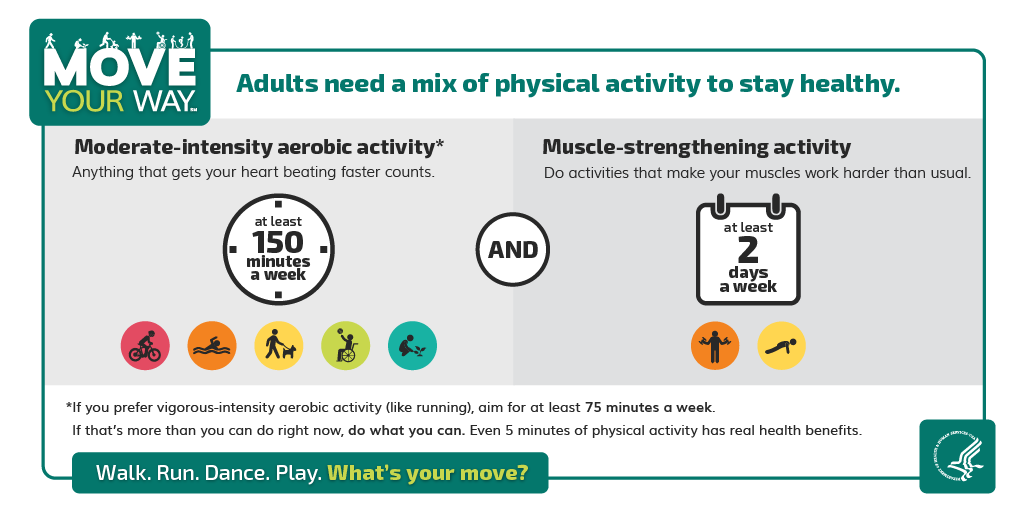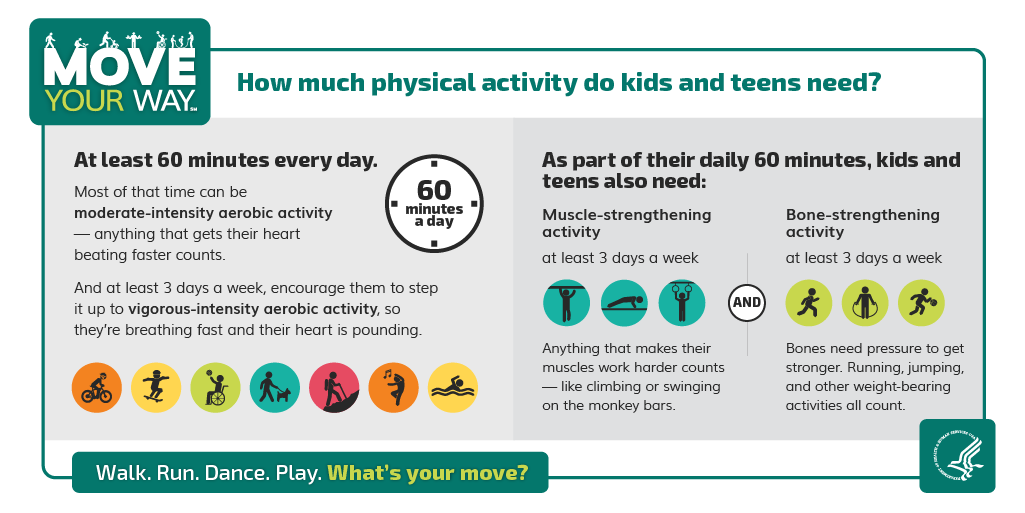Why is it important for me to be active?
Physical activity can provide immediate benefits. Physical activity can help to boost your mood, reduce stress, improve sleep, and sharpen your focus — benefits that can be especially important during stressful times. Physical activity can also help you live a longer, healthier life by reducing the risk of many common chronic diseases, like type 2 diabetes and some cancers.
How much activity do adults need?
According to the Physical Activity Guidelines for Americans, adults need a mix of activities to stay healthy, including at least:
- 150 minutes of moderate-intensity aerobic activity a week
- 2 days of muscle-strengthening activity a week
During stressful times, it’s important to remember that some physical activity is better than none! Adults should move more and sit less throughout the day. If you’re working from home, try taking activity breaks throughout the day or walking around your house during conference calls.
How much activity do kids need?
With many children home from school, parents and caregivers might be wondering how to get kids moving. The Physical Activity Guidelines for Americans recommends that kids and teens ages 6 to 17 get 60 minutes of activity every day. Kids younger than 6 need physical activity too — it helps support their growth and development. Preschool-aged children are active naturally, so aim to help them be active throughout the day and avoid time just sitting around.
Remember, lots of things count as physical activity — and it all adds up! Ask your kids to teach you their favorite game from physical education class or recess, have a family dance party, or challenge each other to learn a new yoga pose or do another push-up.
Is it safe for me to be active outside?
Before making a decision about whether or not to be active outside, be sure to check the latest guidance from your local health department and community or state leaders. In most places across the United States, residents can go for a walk or run as long as they practice social distancing and good hygiene.
Going for a walk, run, or bike ride in your neighborhood can be a good way to get active, as long as you can safely maintain distance between yourself and other active neighbors. If you decide to go to a nearby park or community space, first check for closures or restrictions. Then consider the number of other people who might be there and if you’d be able to ensure enough space — at least 6 feet —between yourself and other people.
If you can’t practice safe social distancing outdoors, stay home and find ways to get active indoors. If you have to go outside near other people — like to walk your dog — wear a cloth face covering.
If you have a yard, gardening and yardwork are also great ways to stay active and count toward meeting the Physical Activity Guidelines.
Can I be active outside with people who aren’t in my household?
It’s important that we all do our part to slow the spread of the coronavirus. That means following local, state, and national guidance. Try to limit social interactions when possible and always stay home if you’re feeling sick.
The safest way to be active outdoors is to stick with members of your household or go solo. When you’re deciding where to go outside, avoid busy areas that might make it hard for you to keep your distance from others.
If you’re meeting up with someone who isn’t in your household, make sure to avoid all physical contact and keep at least 6 feet of space between you at all times. And remember, you don’t have to meet in person to get active together! Consider others ways to stay connected like talking on the phone while walking.
Is it safe for me to go to a park or a playground?
Be sure to follow local guidance so you know if it’s safe to use parks and playgrounds in your community.
Playgrounds
Lots of people use and touch playground equipment, so an empty playground can still be full of germs. CDC recommends that visitors do not use playgrounds, including water playgrounds, within public spaces and parks. There are lots of ways to get active with your kids away from the playground. Consider playing hopscotch or four-square in an open space.
Parks
Parks can help make it easier to keep your distance from others, but not if they’re too crowded. Make sure you look for outdoor spaces that make it easy for you to keep your distance from others. Focus on parks that are close to your home, and avoid traveling long distances to visit a park. It's best to prepare in advance, because facilities — like concessions or bathrooms — may be closed to visitors.
Are there physical activities I need to avoid?
You can continue to do many of the activities you love, but you might have to make some adjustments to be safe.
- Do you love group fitness classes? Try streaming a group workout online in your home.
- Are you used to lifting weights at a gym and don’t have any at home? Get creative! Try lifting canned goods or laundry detergent. Or try some bodyweight exercises — they can help you build strength, just like lifting weights.
- Are team sports your thing? Find an open space to practice your individual skills.
Just be sure to avoid social gatherings, keep your distance from others, and practice good hygiene.
How can I be active without a gym?
There are all kinds of ways to get active at home. Workout videos, dancing, and even active video games are great ways to get moving. Many gyms and organizations across the country are offering free streaming or on-demand fitness options. This might be the perfect opportunity to try something new!
Household chores and gardening are also good ways to get moving, and a great way to multitask. If you can distance yourself from others outside — and it’s allowed under local guidance — take a walk, run, or bike ride in a quiet neighborhood, or hike on a trail away from others.
Where can I find free resources to help me stay active at home?
Without the ability to go to a gym or playground, getting active might feel tougher than normal. Many organizations and agencies on the local, state, and national levels are working hard to support activity in the home during this time.
The Move Your Way Activity Planner is a great way to identify activities you can do at home! Your local parks department or recreation center website might also have guidance. And you can find plenty of free streaming or on-demand videos to help you maintain or improve your physical and mental health online.
Here are a few resources to jump-start your new physical activity routine:
Resources for all ages:
- American College of Sports Medicine provides suggested aerobic and strength-training activities
- Cooper Institute has free videos with tips to help you get active on their YouTube channel
- National Center for Health, Physical Activity and Disability features inclusive videos that people with disabilities can do at home
- National Academy of Sports Medicine shares 9 bodyweight exercises you can do without equipment
- YMCA features Your Y at Home resources for kids and families, adults, and older adults
Resources for youth:
- ACE Fitness gives instructions for creating a simple obstacle course for kids
- American Heart Association shares 25 Ways to Get Moving at Home for kids
- Fit Kids is providing access to a curriculum that kids and adults can use to get active at home
- SHAPE America has instructions for creating a Multi-Game Fitness Card Deck with games for kids of all ages
Is it safe for my sports team to practice?
For now, it’s best to be active solo or only with members of your household. Virtual training options are on the rise, with many offering their services free of charge during the pandemic. Check with your coach or sports organization for guidance on how to maintain fitness and training while following social distancing recommendations.
How do I stay connected to others while being active?
Practicing social distancing doesn’t mean disconnecting with others in your life. Here are some ideas to stay connected and active while apart:
- Call a friend or loved one while taking a walk.
- Post your physical activity plans to social media and invite your network to move along with you.
- Get moving with friends via video chat or virtual streaming service. Motivate each other through a virtual meetup while doing an at-home workout.
- Get creative with your neighbors! Use a neighborhood listserv or phone tree to organize fun things to see in yards, windows, or apartment balconies, like a social distance scavenger hunt or art show, or a fun challenge like wearing your Halloween costumes on a walk.
For more information about coronavirus and COVID-19, visit covid.gov and cdc.gov/coronavirus. For more information on all U.S. government activities related to coronavirus and COVID-19, visit usa.gov/coronavirus.





